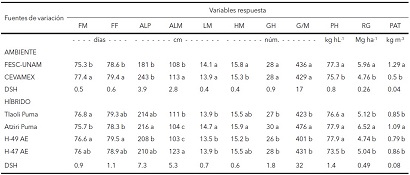Population density and fertilization ef fect on water productivity and yield of corn hybrids in the Mexico Valley
DOI:
https://doi.org/10.28940/terra.v41i0.1577Keywords:
total water, conventional irrigation, irrigation plus precipitation, temporaryAbstract
Food insuf ficiency in corn and water and fertilizer crisis worldwide demand ef ficiency in the use of resources, increasing or conserving production. Thus, the objective of this research is to explore the response of four white maize hybrids released for valles Altos in two environments considering two population densities, two doses of fertilization and an unfertilized control group. Hybrids were evaluated in a factorial arrangement in Cuautitlan (FESC-UNAM) and Texcoco (CEVAMEX), Mexico State, at two planting densities (D1 = 75,000; D2 = 90,000 plants ha-1) with three fertilization treatments (F1 = 160-80-00, F2 = 120-40-00, F3 = 00-00-00). The completely randomized block design experiment was made up of the treatments and the combination of the factors 2×4×2×3 established in three repetitions. The means were compared with Tukey’s test (P < 0.05). In FESC-UNAM with less total water, the result of grain yield and water productivity was 5.96 Mg ha-1 and 1.29 kg m-3 in CEVAMEX 4.76 Mg ha-1 and 0.5 kg m-3; the Atziri Puma hybrid stood out with 6.52 Mg ha-1 and 1.09 kg m-3. No significant ef fect of planting density was observed and D1 resulted with 5.32 Mg ha-1 and 0.9 kg m-3 versus D2 with 5.40 Mg ha-1 and 0.9 kg m-3. In fertilization F1 was statistically higher with 5.64 Mg ha-1 and 0.94 kg m-3. Nevertheless, no dif ference was observed between F2 (5.24 Mg ha-1 and 0.88 kg m-3) and the control F3 (5.19 Mg ha-1 and 0.87 kg m-3), which showed the interaction of the environments with hybrids, of which Atziri Puma stood out at FESC-UNAM (7.3 Mg ha-1 and 1.58 kg m-3). The FESC-UNAM site has productive potential under rainfed conditions with the Puma and INIFAP hybrids.
Downloads
Publication Facts
Reviewer profiles N/A
Author statements
- Academic society
- Terra Latinoamericana
- Publisher
- Mexican Society of Soil Science, C.A.

















